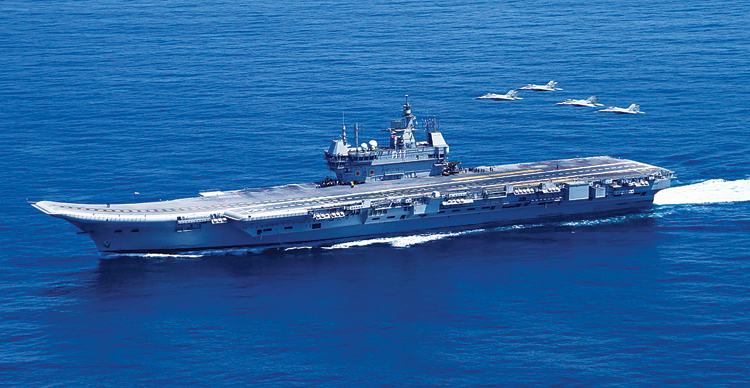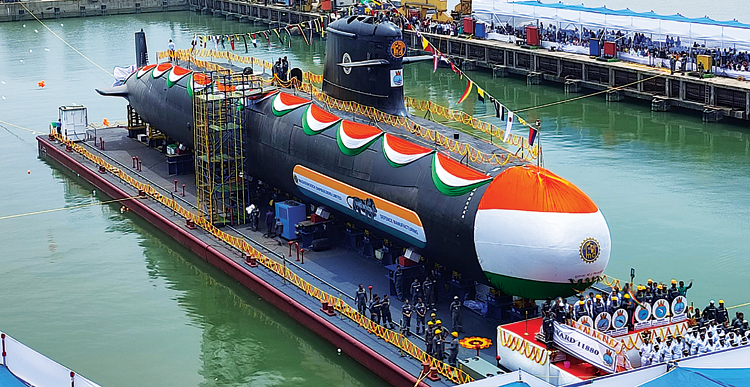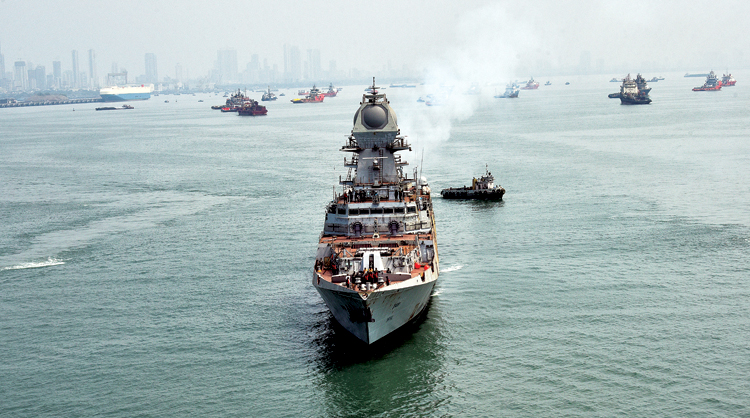INDIAN ARMED FORCES CHIEFS ON
OUR RELENTLESS AND FOCUSED PUBLISHING EFFORTS

SP Guide Publications puts forth a well compiled articulation of issues, pursuits and accomplishments of the Indian Army, over the years

I am confident that SP Guide Publications would continue to inform, inspire and influence.

My compliments to SP Guide Publications for informative and credible reportage on contemporary aerospace issues over the past six decades.
MAKE IN INDIA / REFORMS
Boosting Atmanirbhar Bharat
Five measures to transform India’s journey towards self-sufficiency in defence manufacturing
 | The Author was the Flag Officer Commanding-in-Chief, Southern Naval Command when he retired on November 30, 2021. He is a Navigation and Direction specialist. He was also the Director General Naval Operations and the Chief of Personnel, Indian Navy. |


A lot of good work has been done to move India towards self-sufficiency in the defence sector over the past seven decades, and there are several achievements of which we can be justifiably proud, particularly in the maritime sector. The first two Defence Public Sector Undertaking (DPSU) shipyards, Mazagaon Docks Ltd (MDL) and Garden Reach Shipbuilders & Engineers (GRSE) were created in 1960. As a result, the first indigenous warship, INS Ajay, was built at GRSE in 1961. After that the progression towards a builder’s navy and then, a designer’s navy, was steady. The first indigenous frigate of British design, INS Nilgiri, was commissioned in 1972; the first indigenously designed and built frigate, INS Godavari, was commissioned in 1983; the first indigenously built submarine of German design, INS Shalki, was commissioned in 1992; the first indigenously designed and built destroyer INS Delhi, was commissioned in 1997; the first Indigenously designed and built strategic submarine, INS Arihant, was commissioned in 2016; and the first indigenously designed and built aircraft carrier, INS Vikrant, was commissioned in 2022.
Growth in Defence Production and Exports
By 2023, the indigenisation percentages achieved for indigenous warships stood at 95 per cent in the ‘Float’, 60-65 per cent in the ‘Move’ and 50 per cent in the ‘Fight’ components. The achievements in terms of overall defence production and export have also been heartening. After the Defence Production and Export Promotion Policy (DPEPP) was promulgated August 2020, targeting exports of 35,000 crore in aerospace, defence goods and services for the period 2020-25, concerted efforts have ensured that India achieved defence exports of 16,000 crore in 2022-23 – a tenfold increase from 2016-17. More importantly, 70 per cent of the contribution came from India’s nascent private sector defence industry, demonstrating its potential for growth. Overall, over 100 public and private sector defence companies are today exporting defence products to over 85 countries in Africa, South Asia, Southeast Asia and West Asia. Recent additional policy initiatives promoting defence exports include: simplified defence export and industrial licensing processes; Foreign Trade Policy incentives; MEA facilitation of Line of Credit to friendly foreign countries to import Indian defence equipment, etc. In the last two years, there have also been creditable achievements in innovation/ indigenisation under the DIO/NIIO-SPRINT/ iDEX/ TDAC umbrella.
Despite the undeniable progress achieved thus far, many issues remain to be resolved to transform India into a global powerhouse for defence manufacturing and exports. The principal shortfall remains the major import component in the ‘Move’ and ‘Fight’ components of sensors and weapon systems. As a result, India remained the top importer of defence equipment in the world in the period 2018-22 with a share of 11 per cent of all global arms transfers, largely from Russia, France and Israel, as per SIPRI’s ‘Trends in International Arms Transfers 2022’ report. India also did not figure in the top 25 arms exporters in the world who together comprise over 98 per cent of all global arms exports, with India not even mentioned as an arms exporter in the report, indicating its negligible global share. Moreover, over 70 per cent of the 16,000 crore worth of defence exports by India remained low value items and low tech items. It is, therefore, abundantly clear that if India is to enhance indigenisation in the crucial and technology intensive fields of weapons, sensors and propulsion engines, several policy changes will need to be made to India’s defence industry and economics. This article suggests five major changes that would go a long way in boosting indigenisation and exports in the defence sector.
Streamline Planning, Procurement, and Budgeting Process (PPBP)
The first major step is related to our planning, budgeting and acquisition process. India needs to promulgate an apex level security strategy document akin to a National Security Strategy (NSS) to provide the apex political guidance in terms of the threats expected and the measures necessary to combat these threats. Any forcelevel planning and budgeting process in the absence of a NSS-equivalent document (and lower-level policy documents) would be flawed, to say the least. Indeed, the 10-year Integrated Capability Development Plan (ICDP), the 5-year Defence Capital Acquisition Plan (DCAP) and the 2-year Annual Acquisition Plan (AAP) need to be worked out in consonance with the current and future security environment, the nature of future warfare, the types of roles and missions expected to be executed by the Armed Forces, changes in technology, etc, all of which need to specified in the apex and subordinate level policy documents. This is essential to prevent a mismatch between what the government expects and what the Armed Forces will deliver in terms of national security. The PPBP will also ensure that scarce national resources allocated for the country’s security are invested wisely and in accordance with an overall national plan, which synergises all national agencies towards a common goal.
India has achieved significant progress in maritime defence indigenisation, building warships like INS Arihant and INS Vikrant
The second major issue relates to a number of changes that need to be made to our budgeting process and the government’s General Financial Rules (GFR), to make it more efficient and cost-effective. The basic mismatch between our budgeting system and defence capital procurement is that the budget lapses at the end of the current financial year, while contracted capital schemes extend over multiple years. This mismatch is not endemic to India, but is exacerbated by the delays in our procurement process, which tend to shift across multiple financial years, throwing financial planning into disarray. To resolve this anomaly, the Parliament’s Standing Committee on Defence (SCOD) has time and again recommended a ‘non-lapsable’ capital budget. However, this provision is not permissible – both by our Constitution as also by the GFR 2017. The 15th Finance Commission has also recommended a non-lapsable modernisation fund for defence and internal security, which needs to be adopted so that there is more certainty between force-level planning and its financial outlay. There are also several smaller amendments required to be undertaken in the GFR. For example, the GFR does not include provision for either an Option Clause or a Repeat Order. There is also no provision to cater for quality for the evaluation of a defence product to be contracted, and the decision rests solely on the minimum price – the L1 syndrome – which is detrimental to the quality of a contracted defence item. The Government E-Market (GeM) process now has the provision for a ‘reverse auction,’ which has saved the exchequer up to 25 per cent in overall costs. However, this provision is not there under the GFR.
Simplify the Acquisition Process
The third major issue that needs to be resolved relates to further streamlining and hastening our acquisition process, which despite several positive changes over the past two decades, remains rather pedantic. For this reason, it is normally not possible to adhere to the procurement timeline laid down the DAP for major procurement cases, which is stipulated as 74 to 106 weeks from Acceptance of Necessity (AoN) of the case to contract conclusion stage. For e.g. the P-75(I)case was first taken up in 2008 and still remains to be contracted. There are several such examples of delays in the procurement of major weapon systems, leading to capability voids, escalating procurement costs and a tail-chase of technology, which advances many times faster than the procurement process. The reasons for the delays include: the multiple levels of processing of procurement cases within Service Headquarters, the Department of Military Affairs (DMA) and the Department of Defence (DoD); and repetitive financial scrutiny by MoD (Fin) and Main Finance in the Ministry of Finance (for cases requiring approval of the Cabinet Committee on Security). As such, ship and submarine construction after contract conclusion is also a long process, which in India can take between 10-20 years to complete. As an example, Government approval for the Indigenous Aircraft Carrier (IAC) was accorded in 2001, while the ship was commissioned in 2022.

The fourth major issue is the lack of an institutional provision of a single vendor for major defence contracts, due to a fixation on the seeming virtues of a multivendor process (DAP 2020 does have a limited provision for ‘Ab Initio Single Vendor Cases’ which needs to be expanded). This provision was provided for by the 2004 Kelkar Committee set up by the government to recommend changes in the acquisition procedure and enable greater participation of the private sector in defence production. In their report submitted in 2005, the committee recommended (inter alia) the provision of ‘Raksha Udyog Ratnas/ Champions (RUR)’ in the private sector, and the provision was included in DPP-2006. This provision would have brought such private sector companies on par with DPSUs. The RURs were also to be reimbursed 80 per cent of their defence R&D expenditure. Subsequently, the Prabir Sengupta Committee was appointed to select RURs and short-listed 15 applicants. However, the process languished due to allegations of favouritism, opposition from within the Government, the trade unions, the DPSUs and even sections of the private sector. In 2013 the government decided to scrap the provision of RURs, justifying it on the introduction of the ‘Buy and Make’ category in DPP-2012, which was open to both the private and public sectors. However, this did not lead to major gains in indigenisation. In subsequent years the government has taken several additional measures to encourage private sector participation, such as ‘Buy Indian,’ ‘Buy Indian-IDDM’, ‘Make-I’, ‘Make-II’, Make III,’ enhancement of FDI, amendments to the DAP-20, etc, which have further eased funding and support to defence innovation.
However, while there has been growth in the private sector, which has expanded both in numbers and technical sophistication, production of major weapon platforms and systems remains the exclusive preserve of the DPSUs. The reason for this is the episodic nature of orders for major defence equipment, which in the absence of an assurance of future orders, makes retention of human expertise, and maintenance of specialist infrastructure and equipment cost prohibitive for Indian defence manufacturers. This factor is also a major disincentive for investment in defence R&D by the private sector. This leads to a vicious cycle of import dependence or license production where we may get the ‘know-how’ but are unable to obtain the ‘know-why’. Therefore, while multi-vendor competition is a good thing for commonuse and high turnover items, it is a disincentive for major defence equipment.
Achieving defence self-sufficiency will strengthen national security and contribute to economic growth and technological advancement
For this reason, all major defence manufacturers in the world enjoy a single, or at the most a dual vendor situation. They can continue their business because they are not only subsidised by the government, but are also assured further orders as also maintenance contracts for the equipment that they produce. Because of this they have also been able to develop export markets, and the economies of scale thus achieved enable plough-back of funds for R&D enabling constant technological improvement in quality and capability. To facilitate single vendor nomination the US has created the Defence Contract Audit Agency (DCAA) which conducts detailed independent audits of all defence contracts and ensures price reasonableness and quality of contracted items, especially for single vendors. This is a good model to follow, as without single vendor nomination for big ticket and technology intensive defence equipment, India will not be able to build up its defence industry and indigenise the ‘fight’ and ‘move’ categories of our defence equipment.
Create a Dedicated Defence Exports Organisation
The fifth and final major issue is the lack of a defence exports organisation. All countries with major defence exports have a dedicated organisation to handle the entire process of defence exports - from staff requirements to construction, trials, delivery, guarantee issues, etc. Indeed, the entire gamut of issues to acquire, operate and maintain complex defence systems, such as training, spares, operating philosophy, etc requires a dedicated organisation such as the Naval Sea Systems Command (NAVSEA) in the US (for export of naval weapon systems), Rosboronexport in Russia or Direction Generale de L’armement (DGA) in France. One reason why India has been able to export only a limited number of major weapon systems thus far is the absence of such an organisation. It is understood that the Department of Defence Production (DDP) has been requested to set up such an organisation. We need to develop a model that suits our environment, if we are to move up the value chain of defence exports.





